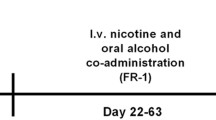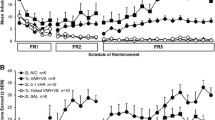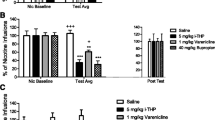Abstract
Background
Preclinical studies with bupropion in rodent models of nicotine dependence have generated equivocal findings with regard to translating the clinical efficacy of the antidepressant as a smoking cessation agent.
Objective
Given that rats are poor metabolizers of bupropion, the present experiments examined (2S,3S)-hydroxybupropion, the major active metabolite, on the positive reinforcing and aversive stimulus properties of nicotine in rats.
Methods
In male hooded Lister rats, (2S,3S)-hydroxybupropion (1.0–10.0 mg/kg IP) was tested on intravenous nicotine (0.03 mg/kg/inf) self-administration behaviour for three sessions (n = 8), and in another experiment, the same doses of (2S,3S)-hydroxybupropion were tested in a conditioned taste aversion procedure to assess the aversive stimulus properties of nicotine, a function implicated in the regulation of nicotine intake.
Results
(2S,3S)-hydroxybupropion attenuated nicotine intake in a manner similar to that produced by mecamylamine pretreatment (1.0 mg/kg SC). This effect on nicotine-taking was specific since these doses had no effect on responding maintained by sucrose presented orally (200 μl of 5 % w/v). (2S,3S)-hydroxybupropion (1, 3 and 10 mg/kg IP) pretreatment failed to modify the aversive effects produced by a small dose of nicotine (0.1 mg/kg SC).
Conclusions
These results demonstrate this metabolite to specifically modify the positive reinforcing effects of nicotine without affecting its aversive motivational effects. We propose that the clinical efficacy of bupropion may be due to a combination of effects produced by bupropion and/or its active metabolite (2S,3S)-hydroxybupropion involving the inhibition of reuptake of dopamine and noradrenaline in reward centres of the brain and the noncompetitive antagonism of neuronal nicotinic receptors.



Similar content being viewed by others
References
Bondarev ML, Bondareva TS, Young R, Glennon RA (2003) Behavioral and biochemical investigations of bupropion metabolites. Eur J Pharmacol 474:85–93
Bruijnzeel AW, Markou A (2003) Characterization of the effects of bupropion on the reinforcing properties of nicotine and food in rats. Synapse 50:20–28
Caggiula AR, Donny EC, Palmatier MI, Liu X, Chaudhri N, Sved AF (2009) The role of nicotine in smoking: a dual-reinforcement model. Nebr Symp Motiv 55:91–109
Cahill K, Stevens S, Perera R, Lancaster T (2013) Pharmacological interventions for smoking cessation: an overview and network meta-analysis. Cochrane Database Syst Rev 5:CD009329
Carroll FI, Blough BE, Mascarella SW, Navarro HA, Lukas RJ, Damaj MI (2014) Bupropion and bupropion analogs as treatments for CNS disorders. Adv Pharmacol 69:177–216
Cooper BR, Wang CM, Cox RF, Norton R, Shea V, Ferris RM (1994) Evidence that the acute behavioral and electrophysiological effects of bupropion (Wellbutrin) are mediated by a noradrenergic mechanism. Neuropsychopharmacology 11:133–141
Cousins MS, Stamat HM, de Wit H (2001) Acute doses of d-amphetamine and bupropion increase cigarette smoking. Psychopharmacology (Berl) 157(3):243-253
Damaj MI, Carroll FI, Eaton JB, Navarro HA, Blough BE, Mirza S, Lukas RJ, Martin BR (2004) Enantioselective effects of hydroxy metabolites of bupropion on behavior and on function of monoamine transporters and nicotinic receptors. Mol Pharmacol 66:675–682
Damaj MI, Grabus SD, Navarro HA, Vann RE, Warner JA, King LS, Wiley JL, Blough BE, Lukas RJ, Carroll FI (2010) Effects of hydroxymetabolites of bupropion on nicotine dependence behavior in mice. J Pharmacol Exp Ther 334:1087–1095
Faucette SR, Hawke RL, Lecluyse EL, Shord SS, Yan B, Laethem RM, Lindley CM (2000) Validation of bupropion hydroxylation as a selective marker of human cytochrome P450 2B6 catalytic activity. Drug Metab Dispos 28:1222–1230
Faucette SR, Hawke RL, Shord SS, Lecluyse EL, Lindley CM (2001) Evaluation of the contribution of cytochrome P450 3A4 to human liver microsomal bupropion hydroxylation. Drug Metab Dispos 29:1123–1129
Fryer JD, Lukas RJ (1999) Noncompetitive functional inhibition at diverse, human nicotinic acetylcholine receptor subtypes by bupropion, phencyclidine, and ibogaine. J Pharmacol Exp Ther 288:88–92
Glick SD, Maisonneuve IM, Kitchen BA (2002) Modulation of nicotine self-administration in rats by combination therapy with agents blocking alpha3beta4 nicotinic receptors. Eur J Pharmacol 448:185–191
Grigson PS (1997) Conditioned taste aversions and drugs of abuse: a reinterpretation. Behav Neurosci 111:129–136
Grabus SD, Carroll FI, Damaj MI, (2012) Bupropion and its main metabolite reverse nicotine chronic tolerance in the mouse. Nicotine Tob Res 14(11):1356-1361 doi:10.1093/ntr/nts088
Hesse LM, Venkatakrishnan K, Court MH, von Moltke LL, Duan SX, Shader RI, Greenblatt DJ (2000) CYP2B6 mediates the in vitro hydroxylation of bupropion: potential drug interactions with other antidepressants. Drug Metab Dispos 28:1176–1183
Johnston AJ, Ascher J, Leadbetter R, Schmith VD, Patel DK, Durcan M, Bentley B (2002) Pharmacokinetic optimisation of sustained-release bupropion for smoking cessation. Drugs 62(Suppl 2):11–24
Liu X, Caggiula AR, Palmatier MI, Donny EC, Sved AF (2008) Cue-induced reinstatement of nicotine-seeking behavior in rats: effect of bupropion, persistence over repeated tests, and its dependence on training dose. Psychopharmacology (Berl) 196:365–375
Lukas RJ, Muresan AZ, Damaj MI, Blough BE, Huang X, Navarro HA, Mascarella SW, Eaton JB, Marxer-Miller SK, Carroll FI (2010) Synthesis and characterization of in vitro and in vivo profiles of hydroxybupropion analogues: aids to smoking cessation. J Med Chem 53(12):4731–4748. doi:10.1021/jm1003232
Perkins KA, Karelitz JL, Jao NC, Stratton E (2012) Possible reinforcement enhancing effects of bupropion during initial smoking abstinence. Nicotine Tob Res 15(6):1141-1145 doi:10.1093/ntr/nts224
Rauhut AS, Neugebauer N, Dwoskin LP, Bardo MT (2003) Effect of bupropion on nicotine self-administration in rats. Psychopharmacology (Berl) 169:1–9
Rauhut AS, Dwoskin LP, Bardo MT (2005) Tolerance does not develop to the decrease in nicotine self-administration produced by repeated bupropion administration. Nicotine Tob Res 7:901–907
Shiffman S, Johnston J, Khayrallah M, Elash C, Gwaltney C, Paty J, Gnys M, Evoniuk G, DeVeaugh-Geiss J (2000) The effect of bupropion on nicotine craving and withdrawal. Psychopharmacology (Berl) 148:33–40
Shoaib M (2008) The cannabinoid antagonist AM251 attenuates nicotine self-administration and nicotine-seeking behaviour in rats. Neuropharmacology 54:438–444
Shoaib M, Schindler CW, Goldberg SR (1997) Nicotine self-administration in rats: strain and nicotine pre-exposure effects on acquisition. Psychopharmacology (Berl) 129:35–43
Shoaib M, Sidhpura N, Shafait S (2003) Investigating the actions of bupropion on dependence-related effects of nicotine in rats. Psychopharmacology (Berl) 165:405–412
Slemmer JE, Martin BR, Damaj MI (2000) Bupropion is a nicotinic antagonist. J Pharmacol Exp Ther 295:321–327
Stolerman IP, D’Mello GD (1981) Oral self-administration and the relevance of conditioned taste aversions. In: Thompson T, Dews PB, McKim WA (eds) Advances in behavioural pharmacology. Academic, New York, pp 169–214
Suckow RF, Smith TM, Perumal AS, Cooper TB (1986) Pharmacokinetics of bupropion and metabolites in plasma and brain of rats, mice, and guinea pigs. Drug Metab Dispos 14:692–697
Warner C, Shoaib M (2005) How does bupropion work as a smoking cessation aid? Addict Biol 10:219–231
Welch RM, Lai AL, Schroeder DH (1987) Pharmacological significance of the species differences in bupropion metabolism. Xenobiotica 17:287–298
Wiley JL, Lavecchia KL, Martin BR, Damaj MI (2002) Nicotine-like discriminative stimulus effects of bupropion in rats. Exp Clin Psychopharmacol 10:129–135
Winer BJ (1971) Statistical principles in experimental design. 2nd edn McGraw-Hill, New York
Yeniceli D, Sener E, Korkmaz OT, Doğrukol-Ak D, Tuncel N (2011) A simple and sensitive LC-ESI-MS (ion trap) method for the determination of bupropion and its major metabolite, hydroxybupropion in rat plasma and brain microdialysates. Talanta 84:19–26
Zhu AZ, Cox LS, Nollen N, Faseru B, Okuyemi KS, Ahluwalia JS, Benowitz NL, Tyndale RF (2012) CYP2B6 and bupropion’s smoking-cessation pharmacology: the role of hydroxybupropion. Clin Pharmacol Ther 92:771–777
Author information
Authors and Affiliations
Corresponding author
Rights and permissions
About this article
Cite this article
Malcolm, E., Carroll, F.I., Blough, B. et al. Examination of the metabolite hydroxybupropion in the reinforcing and aversive stimulus effects of nicotine in rats. Psychopharmacology 232, 2763–2771 (2015). https://doi.org/10.1007/s00213-015-3908-z
Received:
Accepted:
Published:
Issue Date:
DOI: https://doi.org/10.1007/s00213-015-3908-z




